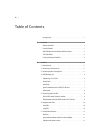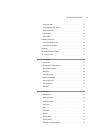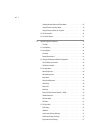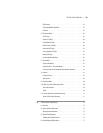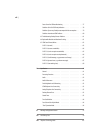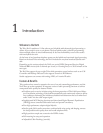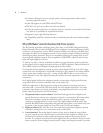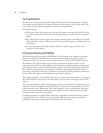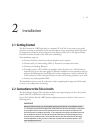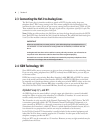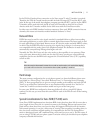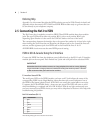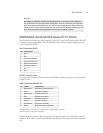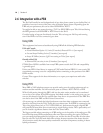
INTRODUCTION | 3
significantly better distortion and signal-to-noise performance.
Lower noise4. . Because they are digital, ISDN lines are not susceptible to induced noise.
Analog lines are exposed to a variety of noise and impulse trouble-causers as they snake
across town on poles and through your building. Hum is the main problem, given most lines’
proximity to pole transformers and AC power wires, but there is also impulse noise from
motors, switches, and other sources. Digital lines convey the bits precisely and accurately
from the network to your studio equipment without any perturbation – so the audio remains
clean. Even when the caller is using an analog phone line, the digital connection on the
studio side makes for noticeably lower noise and better overall quality.
Higher gain and reduced feedback during multi-line conferencing. 5. When conferencing
is required on analog circuits, hybrids are needed to separate the two audio paths in order
to add gain in each direction. When the gain around the loop exceeds unity, the unpleasant
result is feedback. Since the conference path in a studio on-air interface usually includes four
AGC functions, the hybrids must be sufficiently good to cover the additional gain that may
be dynamically inserted by these AGCs. With digital telephone lines, the hybrid function is
more effective – and more reliably so across a variety of calls. at means more gain can be
inserted between calls before feedback becomes a problem.
Digital call setup and supervision6. . Analog lines use a strange mix of signaling to convey
call status. Loop-current drop signals that a caller has disconnected and blasts of 90 Volts
at 20 Hz mean someone wants you to answer. Should we be using a mechanism designed
to bang a hammer against a metal bell to transmit network status information in the 21st
Century?
ISDN uses a modern digital approach to controlling calls and conveying status information
about them. ISDN call set-up times are often only a few 10s of milliseconds, enhancing
production of a fast-paced show. Perhaps more importantly, when a caller disconnects
while waiting on hold, the ISDN channel communicates this status change instantly. is
contrasts with the usual 11-second delay on most analog lines. One of the most common
complaints of talk hosts is that they go to a line where they expect a caller to be waiting,
only to be met with a blaring, annoying dial tone. e chance of this happening with an
ISDN line is nearly zero.
Another common error is the condition where a talent punches-up a line that looks free, but
which actually is just about to begin ringing and connects to a surprised caller. is condi-
tion, called glare, results from the delay in the ring signaling, which comes from the nature
of the analog line’s ringing cadence. ISDN eliminates the ambiguous status period.
We don’t know why the condition of picking up a line which was about to ring and getting an incoming
call instead of dial tone is called glare. Perhaps it’s because the looks air sta give engineers when this
happens too often! If you nd out, be sure to let us know.
Better Line Monitoring, Call Setup and Supervision. 7. Since there is a full-time connection
between the central office and the terminal on the D channel, it is possible to detect when a
line is not working. On an analog line, one discovers a problem only from a failed attempt to
use the line. With ISDN, you can quickly detect when a line is a not working.
Even when ISDN Basic Rate Interface (BRI) lines are not routinely available, ISDN Primary
Rate (PRI) lines are. BRIs have 2 channels per line, while PRIs have either 23 or 30. PRIs are
well entrenched for use with large corporate PBXs, so are likely to be around for a long time.
ere are devices on the market that convert from PRI Telco lines to BRI for internal use, so
this is a way that the Nx12 could be used long into the future on ISDN.



